Filament storage is a small but vital part of the 3D printing experience, but learning how to store 3D printer filament is often a matter of trial and error. This guide will end the guessing game and help you preserve your filament for longer.
It is important to get filament storage right. Some types of filament, like PLA and Nylon, become brittle or swell when exposed to moisture.
Also, dust particles that settle on any filament that is left out can gunk up your extruder. So it is very important to store your filament in a dry, dust-free place.
Put the filament in a bin
The best way to store filament is in a storage bin. You can buy these plastic storage containers at office supply stores, large department stores like Target and Walmart, as well as some Hardware stores.
Make sure you get storage containers that have air-tight lids to prevent humidity from getting inside.
Pro Tip: Also, try to get clear bins if you can so that you can see what filaments are inside without opening it up. It’s not necessary but it makes life a bit easier.
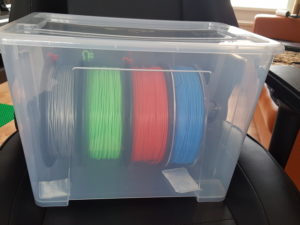
Best Desiccants For Filament Storage
Next, put a desiccant of some kind in the bin. That will keep the humidity low and protect the filament from absorbing too much water.
Rice
A popular desiccant is a porous bag of rice. Rice naturally absorbs moisture from its environment.
So if you put a few cups of rice in a sock or shoebox and place it in the bin, it will absorb any humidity that gets inside and keep the filament dry. You can also you silica beads or gel packs.
| Rice |  | Rice is an age old desiccant material. In ancient times, rice was used to keep other foods and objects dry during storage and transport. Place a cloth bag, sock, or just an open container of filament in the bottom of your filament storage bin. It will keep your filament dry by absorbing humidity from the air inside the container. |
| Silica |  | Kitty litter is a good source of silica desiccant, believe it or not. In fact, kitty litter is mostly silica beads. Simply put some kitty litter in the bottom of your filament storage container to keep your filaments dry. |
| Silica gel packets |  | Silica gel packets are a common desiccant. They are great for keeping filaments dry when they are in vacuum sealed packages or plastic bags. |
Dehumidifiers
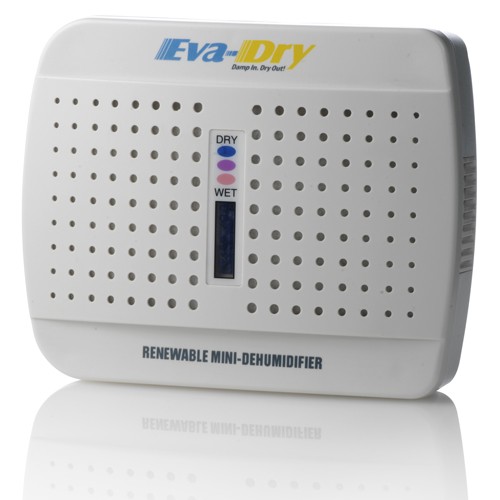
But Dissicants aren’t the end of the matter. The environment you keep your filament in also matters. If you are storing your filament in a basement or workshop, you might want to take some extra precautions to keep the humidity levels in check.
One way to do that is to set up a dehumidifier in the room where you do your printing or store your filament. Even a small dehumidifier will help a lot.
Check out our guide to dehumidifiers for workshops for some options.
Temperature
Another thing to keep in mind is temperature. Don’t leave filament next to a radiator or anywhere where it could warm up enough to become soft. If it becomes soft, your tolerances might get warped and the filament could become unusable.
Try to keep the filament in a cool or room temperature environment, especially in the summertime. If needed, pick up a small air conditioner or even a mini-fridge.
What does water do to filament?

Exposure to water will cause some filaments to chemically degrade, especially polyester filaments. PLA is a polyester, meaning that it is composed of ester chains.
Water can break up these ester chains, and the process by which it does that is called hydrolysis. Once hydrolysis goes too far, the filament will become unusable.
Thankfully, wet PLA is often salvageable if swift action is taken. Let’s look at why.
Here’s exactly what happens when PLA comes into contact with water:
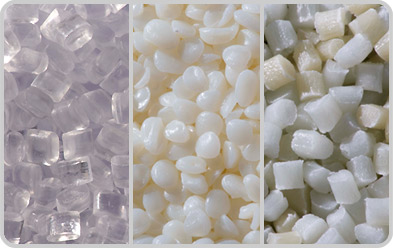
While hydrolysis of ester linkages by water will degrade PLA over time, the PLA will at first simply absorb the water without breaking down on a molecular level.
Absorption, in this case, is simply the process of water molecules diffusing into spaces between the strands of polymer chains that make up PLA filament.
The diffusion of water into these spaces causes the filament to swell up a bit but doesn’t immediately break up polymer chains.

Once the filament has absorbed water, hydrolysis of the ester bonds that PLA is made of will begin. But polylactic acetate does not undergo hydrolysis all at once. It is a gradual process.
That means that PLA can be dried out before hydrolysis completely ruins the filament. Just pop your spool in the microwave for a minute or two, leave it in a bin with a desiccant, or expose it to a low heat source for a while and it will dry right out.
You can then print with it without any problems. But if you don’t dry it fast enough, the hydrolysis will break apart too many ester chains and the PLA will become too brittle to use.
What happens when other types of filaments get wet?

What will happen to other filaments if you don’t learn how to store 3D printing filament properly?
PHA has good resistance to water. But ABS, Polycarbonate, and PETG are hygroscopic, meaning that they absorb water.
Thankfully, they won’t break down the way PLA does. Nylons are hygroscopic as well, and they do decompose when in contact with water.
However, the process is so slow that you would never notice it. For all of these polymers, if they get wet or absorb moisture, you can dry them and use them.
For a description of Hygroscopic polymers, click here to visit Plastics Technology.
How to dry out filament

There are a few ways to dry filament that has absorbed water. Each has advantages and disadvantages. But all of them will dry your filament out well.
- Microwave: I know it sounds crazy but it works. Place your spool in the microwave and zap it for about 30 seconds. You might hear some popping and sizzling sounds as the water evaporates out of the filament. Once it’s done, let the filament cool off before repeating the process if necessary. Warning: make sure the type of plastic is microwave safe (PLA is not, for instance).
- Desiccant: Place the filament into an airtight container with a desiccant, such as a bag of rice. The spool will be completely dried out in a day or two.
- Heat: Place your filament near a heat source. Be careful not to let the filament get too hot, otherwise, it may begin to melt and your tolerances will be off. After 5-15 minutes, it will be dry.
How long does 3D filament last?
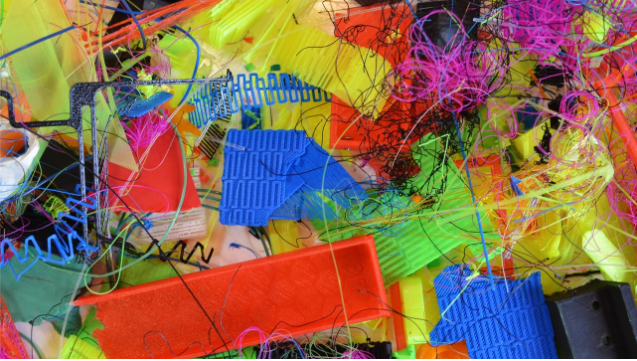
Most regular polymers used to produce filament can last indefinitely so long as they are stored properly. Few if any plastics must be used within a specific timeframe. Even when exposed to moisture, many plastics will not degrade.
That being said, each type of filament has different degradation properties. Nylon, for instance, does degrade when in contact with water over months or years.
PLA will degrade faster in water because it is a polyester and therefore susceptible to hydrolysis, as explained above. But ABS will usually only begin to decompose when exposed to direct sunlight.
And PET only degrades at higher temperatures (above 570ºF) and so are unlikely to decompose quickly.
How To Store 3D Printing Filament In Other Ways
Storage bins are the best way to store filament. But there are also filament racks and shelving.
Here are a few ideas to get you started:
 | Large, 5 gallon ziplock bags are a very common way of storing filament. Simply place a spool in the bag with a desiccant and you are good to go. |
 | Plastic storage bins are probably the most popular way of storing filaments since they are easy to use and customizable. Include a desiccant in the bottom of the bin to keep your filaments dry. |
 | Filament safe is a brand of filament container that keeps each spool in an individual container. That way you don't have to expose every one of the spool to air when you need to open the container to use the filament. You can put a desiccant in each section and label the lids. |
How to create the ultimate filament storage container
You can create the ultimate filament storage unit by making a few simple modifications to a plastic storage container. This is the best way we know how to store 3d printing filament.
Basically, you can create a container that keeps your filament dry and that you never have to remove filament spools from in order to print.
The filament simply unspools within the container and exits through holes in the side of the container. It looks like this:
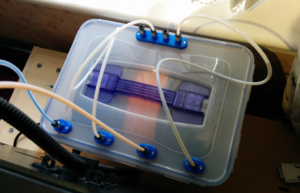
The process is simple. First, install a rod across the width of the box (can be a wooden dowel, metal or plastic rod). This will act as the spoke of the spool rack to keep your filament elevated and free spinning.
But importantly, it should allow the spools to unwind independently so that each spool can be used freely without requiring the other spools to spin as well.
Next, drill several holes in the sides of the bin. The reason you need to make holes in your box is to allow the filament to unspool through the side of the box to your printer so that you don’t have to remove the filament every time you want to use it.
Once you’ve drilled your holes, you are going to install Bowden feeder tubes and a bracket in each hole. Make sure to calk the brackets with ABS calk so that they are airtight.
What you will have when you are done is the best way we know how to store 3D printing filament using basic materials and tools.
How to clean dusty and dirty filament
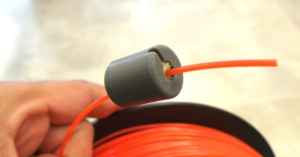
Cleaning up dusty or dirty filament is kind of a pain, but there are some nifty tricks you can try. The most efficient way to do it is to wind the filament from one spool to another while holding a towel around it.
As the filament passes through the towel, it will wipe off any dust or dirt. You can also get filament dust filters that attach to your 3D printer. They are basically sponge holders with a hole in the middle.
The filament will pass through one of these small devices before it enters the hotend and the sponge will wipe off any dust particles that might be on the filament. Check out some of the filter designs on Thingiverse and print your own.
How to fix tangled filament and poorly wound spools

One of the reasons why it is important to make sure you store your filament properly is to avoid making a mess and tangling filaments. Filament tangles are surprisingly easy to create.
It happens often when filament falls off of a spool and gets mixed around. Other times, the tangle is created by the manufacturer during winding.
So how do you fix a tangle of filament?
- The simplest tangle occurs when the end of your filament is under one or more coils of filament on the spool. To fix it, unwind the spool until you reach the tangle and pass the unwound filament under the spooled filament to release it. Then wind the filament back onto the spool.
- For more intense tangles you have to start by pulling the filament tangle apart and spreading out the mess. Find the loose end of the filament and wrap it around something round, like a tin can or a coffee mug. Then start winding the rest of the filament around your object. Every time you come to a snag, thread your object through the tangle to free the snag. Then continue winding until you come to the next snag. Eventually, all of the spool will be untangled and wrapped around the object.
Conclusion: How To Store 3D Printing Filament
At the end of the day, storing filament properly is important if you want to preserve filament for the long term. It’s especially important if you are not printing very often or if you want to collect different types of filament or different colors.
Thankfully, it’s relatively easy to learn how to store 3d printing filament. For PLA and ABS, all you really have to do is buy a plastic bin and throw some rice in the bottom of it to act as a desiccant. Then put your filament in and you’re good to go.
Leave a comment if you have any questions. Hopefully, this guide helped you get started.

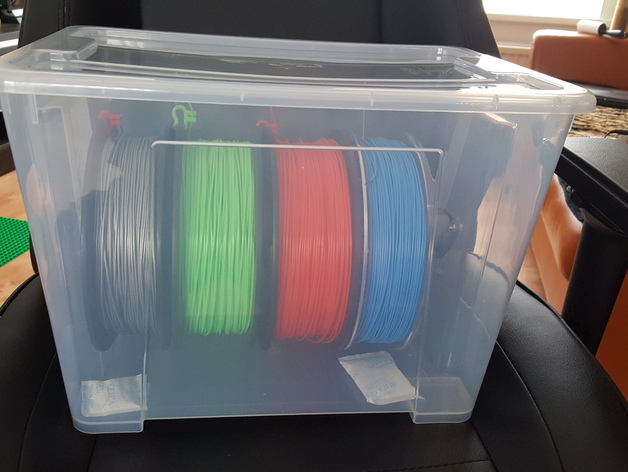




Thanks for mentioning that 3D printer filament shouldn’t be left next to anything warm, as it can melt. One of my friends actually has a 3D printer. These tips could really help him properly care for the filament, so thanks for sharing them.